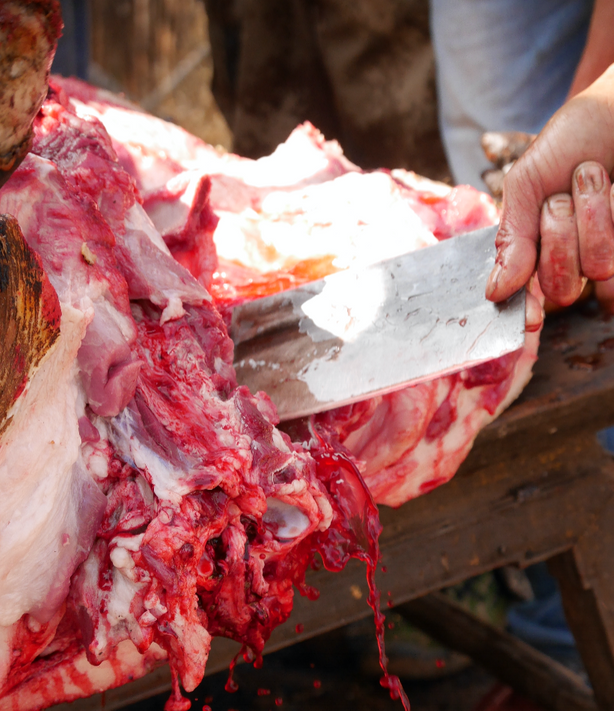Lu Sääf
路先生
Article 1
The spirit of China - in a bamboo

Some say the origins of wine started with monkeys hiding fruit in a tree. They forgot about it and eventually the fruit then started to ferment. Humans picked up the vinous scent from the fermenting fruits and became enchanted by its flavors and physical effects. Tale or facts it is an enticing theory. But what if a tree could produce wine within itself for real? What if with the aid of ingenious people and a humble plant, a common tipple could be turned into a unique treasure?!
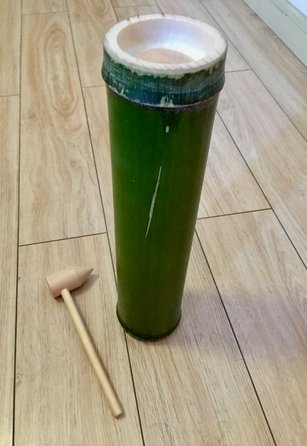
There is something romantic about bamboo. The green luster, the gentle rattling of leaves in a spring breeze, the sway of ten meters long stems, and the pleasure of the crisp bite of the year’s first shoots. Throughout history, the Chinese have utilized bamboo for building their homes and connecting people and lands with bridges. They have fed their children and nourished their health with it. It is a plant that embodies the mystery of China. If you ever step foot in a bamboo forest, take a deep breath and take it in, take in the spirit of China.
Despite my deep affection for this plant I admit my puzzlement as I was gifted a joint of bamboo for my birthday. Oh yes, which was also accompanied by a small pointy wooden hammer. However, the inside of the bamboo hid a surprise, bamboo spirit, locked inside the joint by thin woody membranes separating one joint from the next, oily to the touch, thin but sturdy. The pointy wooden hammer was, as one would expect, used to crack open the membranes to get the luscious beverage out of the bamboo.
As no entry hole was visible my curiosity set in. How on earth did they get the wine into the bamboo? After a few days of baidu-ing I stumbled upon an article mentioning a similar phenomenon in the southern province of Fujian. As it only mentioned the name of a nearby village chances seemed small to find the place, but since a grass filled with booze is still quite a rare acquaintance a 15 hour trip seemed a reasonable trade off for the chance to see a giant boozed up grass in real life.
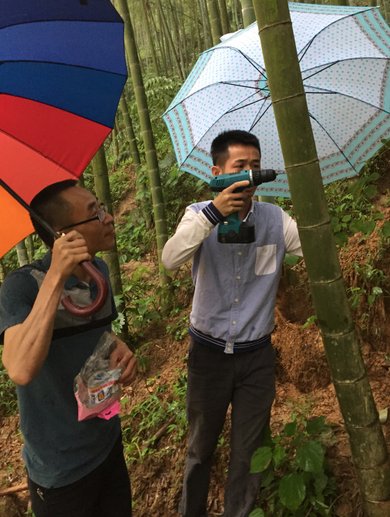
Well down amongst the enchanting green hills of Fujian it beame clear that this was not a well known enterprise, nor was the nearby village of my destination known to the local Minnan people. Hitchhiking seemed like the only option and so it was that I found myself, on my birthday, in the pouring rain and with the dusk setting, stepping out of a car in the rural mountains on the outskirts of a town so grey one feels sorry for oneself as soon one’s eyes falls upon it. Up ahead was a tiny little restaurant, good a try as any I thought and went to ask the sat lady apparently running the place if she by chance knew of any one who put spirits inte bamboo in the vicinity. To my surprise she said ”Yes, that’s my friend”. After politely declining an invitation to join in on a snail feast from the only table of guests the boss had managed to get hold of her friend and handed the phone over. On the other end was the calm voice of Mr Linkai. ”I am 200 km away but I can come in the morning to meet you.” Astonished by the kindness I made my way to the best (only?) hotel in town to await the next day.
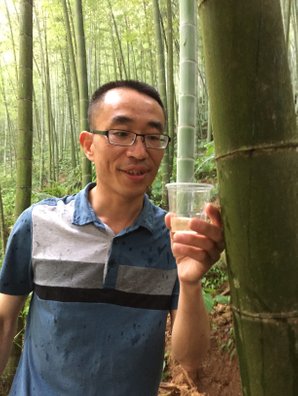
The next morning a car pulled up on curb, it was one of those vehicles that looked like it would fall apart if you poke it on the wrong spot. Same went for the driver of the car, alike my host, Mr Linkai, whose thin body much matched the look of the tall bamboo sticks he committed is life to. After picking up his youthful manager Lin we set out on a winding road up the mountain. The mist encircling the winding road framed by bambu forests is a sight hard to forget. We stopped the car on a dirt road, the red soil contrasting the surrounding tropical green in an almost surreal shimmer. Up the mountain we made our way and suddenly came to a halt in a ravine enveloped by bamboo forest. ”We do not mark the trees, we know which they are” the manager said. A good defense against theft I guess. And that is probably necessary as Mr Linkai informed, the price for bamboo sold as wood claimed a mere 10 CNY (1,5 USD) per bamboo, whilst the bamboo infused with wine would claim as much as 600 CNY per bamboo!
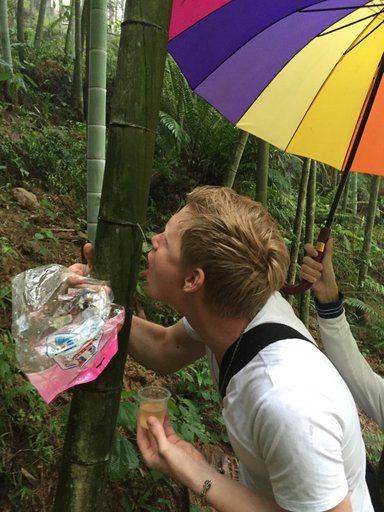
”Welcome to our wine factory!” manager Lin cheerfully shouted as I clang to a bamboo to stop me from sliding down the steep slope. I was still not sure what would happen, even more so when manager Lin picked out a drilling machine and started to examine the bamboo. He halted to explain the principle of which they produce their fine beverage. ”Other places in China also make bamboo wine, but no one makes it like us. Others may use harvested bamboo, cut the joints apart, drill holes in each, fill it with mediocre spirits and let it sit for a few weeks to allow the liquor to pick up some bamboo flavor. We don’t do that, here we inject top quality sorghum liquor when the bamboo is young. As this particular type of bamboo grows fast the injection hole heals fast and a year later it is ready for harvesting. We can only use one, sometimes two joints per bamboo otherwise the alcohol will kill the bamboo, it can't take the booze. But more important is that this type of bamboo contains a lot of liquid and as the bamboo is alive its natural juices blends with the spirit to create a unique beverage. After we harvest it, we treat it as a fresh produce, it needs to be consumed quickly, otherwise the bamboo dries out, may crack or the liquor deteriorate in flavor. We usually cut it down and sell it per joint to customers, but what you will try today is, hands down, the best way to savor this drink”. He knocked his knuckles against the green stem, apparently content with the muffled sound he then drilled a hole, empty. ”Nothing?” he shrouded and knocked again, one joint below the previous. ”There it is!”. Tearing another hole with the drill and then like something out of a wine aficionado’s utopia the bamboo spurts out a waterfall of alcohol. ”Glasses!?”. With fumbling fingers Mr Linkai pulls out a few plastic cups to collect the mysterious liquid.
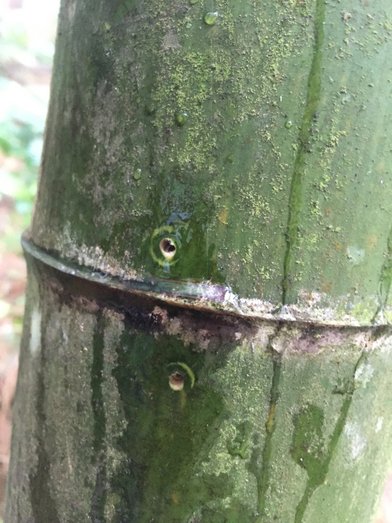
The glass immediately turned hazy. Despite the early morning hours it was already 25 degrees but the liquid in the glass was, to my surprise, cool. Familiar with sorghum spirits and its traditional transparency the fine pale yellow of the drink was intriguing. ”Its the magic of the bamboo, the spirit is clear as water before it goes in.”
Bamboo is widely used for its cleansing and anti bacterial properties. It is easy to understand as the first sip make its way down it feels like the drops rinses clean its path down the body. It feels like drinking a crisp misty morning in a still bamboo forest. The crispness and clean finish almost lifts the palate, swaying the mind in an almost meditational way.
Infused with bamboo the shimmer of the morning sun among the green stems and the singing leaves was ever so intoxicating. A forest of wine, giving life and pleasure to its inhibiting people, may it continue to grow and enchant many more with the spirit of China.
Article 2
Killing pig, living culture
The pig is central to many cultures around the world, in particular to many of the ethnic groups inhabiting China. Even the Chinese character for home consists of a pig under a roof. Perhaps it comes as no surprise that that the greatest annual feast for one of these ethnic groups, the Bai minority, in the western province of Yunnan revolves around the pig. This is the story of how a family in a remote mountainous celebrate tradition and cherish their resources.
It was still pitch black outside. Me and my companion and namesake Mr Ludwig stumbled out onto the cobblestone paved streets in a little fishing village near Shuanglang on the eastern shores of the Erhai lake in Chinas western Yunnan province. It was early February and the air at 2000m above sea level was chill and crisp. We had both been anticipating the day’s event, and we both knew that if you want to catch the killing of a pig you need to be up before the dawn. With a few minutes until our host was planned to arrive we made our way to the only light down the narrow alleyways, which conveniently belonged to a rice noodle vendor. After downing a big stone bowl of rice noodles loaded with heaps of chilis to drive off the cold and the fumes still lingering from last evening’s excursion to the local distillery we were ready to tackle the day.
Restlessly we saw the time pass, they were late. Of course they were, timeliness does not take on the same degree of importance here. We both knew this but still could not help but restlessly pace back and forth. Finally the car approached. Our host, old man Yang with his thick round dark glasses, to protect him from all evils, smiled at us. However the feeling of relief was then again interrupted as we stopped just two minutes later on the roadside next to a table filled with large chunks of pork and a man with an axe-like cleaver still working hard on chopping down the creature’s flesh. ”We need to bring some lunch and then we kill the pig after” our host said. As neither me or my namesake had ever heard of such a thing as killing a pig after lunch worries flamed up that we may miss the slaughter and the trip would be in vain.
We began to make our way up the mountain on winding dirt roads as the dawn over the Erhai lake turned the mountain ranges into a glowing pink and turquoise vail with the soil on the slopes glowing dark red like glimmering embers. We passed one mountain range, then another, and then hours later came to a halt on a point overlooking the valley and the mountain path that connects Bingchuan with the Erhai basin. With this breathtaking view as a backdrop in front of us was one of those ”in the middle of nowhere” houses, where time seems to stand still and where the surroundings and your own efforts dictate the supply for your dinner table.
Behind the shadow of a Sichuan pepper bush, was the scene of the event, a courtyard with sun scorched dirt bricks plastered with mud, much different from the stereotypical white and blue Bai houses buildings so characteristic of the Erhai basin we had left earlier that morning. This was another world. In eyesight was a charcoal kiln, there were beehives carved out of the courtyard’s walls, ceramic fermentation jars scattered around beside and on top of the courtyard walls. A bit further in was a huge pile of plucked dried corn cobs that are commonly used for fuel and next to it were the pens, above which’s doorframe a sign stated ”The pig is fat and mule strong”.
Many people had already begun to gather and the quick lunch to precede the evening’s feast was already on its way. But what a lunch. It was pleasure in sustainability defined. Beyond organic, beyond farmers markets. the food was grown and processed on the premisses. Potatoes flavored with chili oil, home made tofu with scallions and fried chili, sour and spicy carp with quince, white beans with a touch of pork fat, bork belly from last year’s pig which had been cured until golden and fried until translucent, eggs and tomatos, and finally the pork we brought from town, now thinly sliced and served raw. I should emphasize that the latter is the most representative and festive dish of the people in the Dali area. They call it ”raw skin” 生皮, and the dish usually consists of thin slices of raw pig skin, sometimes raw fat, quite often raw meat and occasionally raw offal. Sometimes it is served with strips of radish and always with a fiery sour and spicy dipping sauce heavy on aged rice vinegar.
Suddenly there was a high pitched squeal, ”it is time” old man Yang said and we rushed out to see the events unfold. A man thrusting as he backed out of the pen strenuously clinging onto the hind leg of a pig, the latter seemingly quite unwilling to be pulled into such commotion. Several men jumped to the aid, binding the pigs snout and four legs together, then with a stick inserted between the legs lifting it up, dropping it, which unsurprisingly inflected further ear piercing squeals, then finally carrying it into the courtyard and placing it onto one of the tables that had swiftly been cleared after lunch. As five men held the pig down with all the force they could muster, an elderly woman with a face much similar to the ridged mountainous surroundings moved in behind the pig and underneath its bum then lit sacrificial money and incense on fire. The smoke ensnared the gathering crowd, the spirits had been pleased.
One of the men pulled out a 30 cm long dagger and thrusted it into the pigs throat, blood sprouted everywhere. I wondered were they not gonna collect the blood?, ”Yes of course, but first the blood should spray out over the courtyard as a blessing, the more it sprays the better” Mr Yang explained. A second later a pot with some chili, salt and water was put beneath the pigs throat to collect the remaining blod. It was said that the seasoning would stop the blood from coagulating until it could be put into a steamer.
As the twitching slowly came to a halt the pole was again inserted between the pig’s legs and under joyous chattering it was carried out of the courtyard and placed belly down on the hillside below the Sichuan pepper tree. ”Let’s burn it!” someone called out. A dozen young men swiftly started to cover the pig with sticks and branches. Then, there was fire, lots of fire. Flames raged the creature until the fire got so pig it enveloped the whole animal. When it came into view again and the flames had settled down the previously lustrous pinkish skin had turned a pitch black color making the pig more resemble charcoal than meat. The process was then repeated as the pig was turned from side to side adding more firewood scorching the skin thoroughly on all sides. ”More fire!” someone shouted as a pen with chunks of coagulated steamed blood was brought out for all to snack on. Imagine the texture of jelly but with a slight crunchiness to it and the flavor of fragrant Sichuan pepper and warming chilis. Not a bad finger food while savoring the burning spectacle.
The father of the household squatted next to the charred pig inspecting it thoroughly as the fumes kept rising from the body. A table was placed on the steep slope and the pig was put on top. Kids came bringing pens of water, another two men brought cleavers and together they started to rinse and scrape away the blacked surface of burned bristle and resin. A golden cracked surface appeared. This was it, the treat that everyone had been longing for the whole year. All guests had now gathered around the pig as the cleavers turned from scraping to slicing, portioning out the crisp skin into chunks for the crowd to savor. But I could see how the butchers themselves both aimed for the delicate pieces underneath the armpits, the chef’s treat.
As the pig was pealed a smaller chopper was inserted into the ear twisting it around until the desired bit was loosened and then discarded. Then the head was dislocated and carried inside for another cleaver to break it down further. Still outside, very carefully the belly was opened. Meticulously the interior was part by part extracted and passed onto the next pair of hands to continue the cleansing. As the meat and bones were broken down they got carried up into the house and placed on the leaf covered floor on the loft. A young woman, flanked by her young boy squatted on the floor, the mother wearing way to high heals for the chosen posture but with skilled hands and a focused eye she grabbed a bamboo chopping board, a cleaver, a chunk of meat and still crunching on the floor started with a incredible speed to slice the meat into paper thin strips. Above her hung fatty chunks of last years pig that had been salt cured and preserved. A man came climbing up the stairs and placed another two cleavers beside her. Without lifting her head or loosing momentum she changed the blunt cleaver and kept slicing. The blunt knife was carried downstairs for another family member to sharpen it on a sand stone. Lean meat, skin with fat and liver was sliced into melt-in-the-mouth-thin strips. This was the main dish, the dish you get once a year at best. Your own pig, fed with your own vegetables, sacrificed at New Year and broken down according to age old traditions.
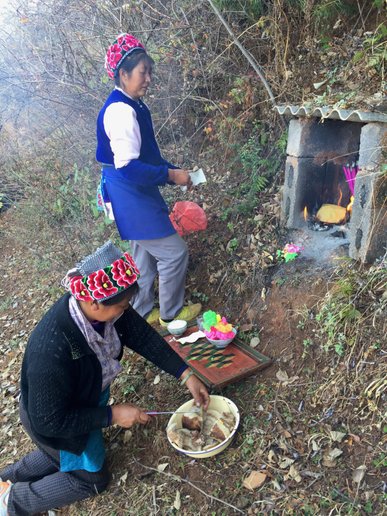
Suddenly two middle aged women also came climbing up the stairs, they begun to flip and turn the chunks of meat, quibbled among themselves for a moment but finally settled on a few pieces. ”We’re gonna go pay dues to the mountain gods”. On a tray they carried colored rice paper, incense and pork. We wiggled our way through the army of cousins and grannies working away in the kitchen, out through the crowd of children snacking on deep fried cheese besides pots of simmering soup. Up the slope we headed, but had to side track a bit as to not disturb the two cows blocking the path. A bit further up the hillside the women came to a halt and kneeled down by a small shrine with two figurines. Incense was lit and placed together with some of the pork and rice paper in the shrine. ”Come join us and bow in reverence”. We bowed, head all the way down into the soil. Heading down again, the golden cow who had blocked our path on the way up turned its head and stared at me, but this time with soft eyes. I could not help but feel humbled, and grateful.
Back down again the dinner tables were just about set in the courtyard. With the good graces of our host, we were sat at the elders’ table in the shadow of the intestines and lungs that had been hung up to dry. These men have a certain aura around them that tell their stories. Their eyes speak of hardships but at the same time of having come to peace with the past, and of a desire of living in the present after so much time lost. This day, when they lived their culture, when they shared the fruits of their families labors and traditions I sat in admiration and humility.
I glanced over Mr Yang’s shoulder, on the kitchen doorframe the words ”Harmony of the five flavors” were plastered, and from within a steady stream of overwhelmingly delicious dishes kept appearing. One of the elders stood up and poured me a glas of baijiu and we raised it in celebration of the evening’s feast and unlikely friendship, singing the gratitude of the pig who gave his life and was embraced into this cultural manifestation. This is what it looks like when culture is lived, when culture in its truest meaning is a reflection of how people live their lives.
More articles coming soon...
